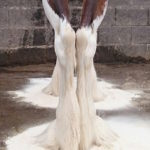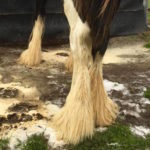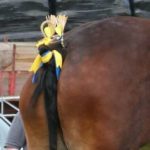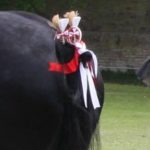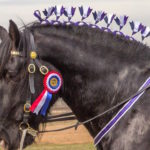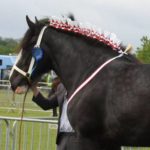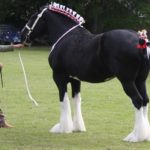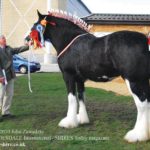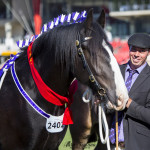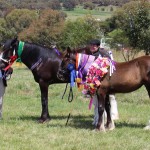You’ve been training, oiling, feeding and washing your horse for some time and show day is finally here…
What do you do now?
Here’s a rough idea of what show morning looks like for us…
Arrive Early
The last thing you want to be when showing horses is rushed. A lack of time to prepare creates unnecessary stress for everyone. Check the program start time online and make sure you’re there early so you can get ready and be in marshalling at the right time.
We always plan the amount of time we think we’ll need generously and then add half an hour. For example, if we were showing one horse we’d allow: fifteen minutes to unload and get gear out, fifteen minutes to get the horse clean, fifteen minutes to put in sprigs and a tail bun, an hour to put in a mane roll and fifteen minutes to get the final touches done and the handler changed. That’s two hours in total, so if we knew we wanted to be ready ringside at 9am, we’d aim to arrive at the show at 6.30am.
We know we won’t use all of that time, but we’d far prefer to be able to prepare without rushing and have the spare time up our sleeve if something goes wrong. Once ready, we’ll head out for a walk so everyone can stretch their legs and then wait ringside. In our experience, the ability to let the horses see everything and then rest before their turn in the ring results in much more settled show partners.
Get The Horse Clean
As soon as you’re parked and unloaded, you’ll need to get the horse clean. Chances are you’ll have washed and rugged the horse the night before at home, so you’ll be checking for stains on the legs in particular. If necessary, wash the whole horse again. Showing is about presenting your horse to the best possible standard, so it needs to be sparkling clean. Don’t forget to pick the horses’s hooves out.
Dry The Feather
Obviously you don’t want to be taking your horse out into the ring looking like a drowned rat! The best way to quickly dry the feather in heavy horses is to use wood flour on the legs. Wood flour is like a coarse saw dust and quickly absorbs the water in the feather, then drops out.
Apply wood flour generously to the legs, fluffing up at the back of the leg and smoothing it downwards at the front. Leave it in for a few minutes so it can absorb the water and then gently comb it out.
Get The Paperwork Done
At most shows you’ll pay entry for yourself at the gate, but once you’re settled in you will also need to find the show office so that you can enter your horse and sign the competition waiver. They’ll give you a ticket or wrist band, which you wont be able to enter the ring without.
Brush Everything
Brush the horse all over and comb out the mane and tail. You’ll need everything to be tangle free so you can put your decorations in.
Put Tail Bun & Decorations In
Put in your tail sprigs and tail bun, then add your decorations. While I’m doing this, I also put in the anchor plait for the neck ribbon.
How a tail is presented varies between breeds and based on how long or short the tail is.
Please see How To Plait A Shire for how to videos on both long and short Shire tail braiding.
Put The Mane Roll In
Assuming you’re showing an adult horse, you’ll most likely need to put a mane roll in. Again, the way this is done and on which horses varies between breeds.
Tie the horse’s head up high and put in your mane roll. Take your time and ensure that the plait is nice and tight so it will stay in.
Please see How To Plait A Shire for a how to video on putting in a Shire mane roll.
Polish!
Use a smooth polishing brush or mitt to give the horse a final brush. If you’d like to use some sort of body shine product, now is the time to apply it but be very careful to avoid the mane roll. Shine products tend to make things slippery and you don’t want your mane roll coming out!
Get Dressed In Handler Attire
Change into the ring attire you have selected, making sure that you have your wristband on or ticket in your pocket. Check for hat, jacket and cane.
Apply The Finishing Touches
Apply some talcum powder to the horse’s white legs – this brightens the white up. Most of the talc will fall out on the way to the ring, leaving the feather looking a bit brighter but not super powdery. Ensure you’ve cleaned your hands after using the talc so you don’t get it all over yourself and the horse.
Change the horse into the show bridle or halter and lead you’ve chosen.
Walk To Ringside/Marshalling
We like to be ready at the side of the ring or in marshalling with plenty of time to spare. Local show programs often don’t have designated class times or run early if there aren’t many horses in the classes before yours. Make sure you’re keeping an eye on your ring so you can be there when you need to.
NB: You are the only person responsible for getting yourself to your class on time. Show organisers and stewards are busy doing their jobs and will not come looking for you. If you’re late and you miss out, so be it.
Remember Ring Etiquette
Just a few quick points to remember:
- Be polite to the judge, steward and other competitors at all times.
- Listen carefully to the instructions given to you and follow them to the best of your ability.
- Accept that the judge’s decision on the day is final – if you can’t be gracious about both winning and losing, you should not be showing.
- Congratulate the place getters.
In The Ring (Led Classes)
At most shows, you can expect that the competitors will be asked to walk in a large circle around the judge, then line up, then individually work out.
When walking in the circle, make sure your horse is stepping out well but do not allow it to trot. Whatever you do, don’t dawdle – if the horse in front of you is moving too slowly you can overtake it on the outside. The judge needs to see the active pace of your horse in order to assess it properly.
When you’re standing your horse in the lineup, make sure you’re paying constant attention to it. Stand facing your horse so you can keep it ‘stood up’ correctly – head up, front legs square, hind legs together with feet next to one another – while also keeping one eye on the judge. When the judge moves to assess your horse, they’ll likely inspect the horse closely, ask you a question or two, feel the horses legs and then request you do your workout.
Most judges will use a workout that involves both walking and trotting, generally in a line straight out from where you were standing and then back. They may also ask you to back the horse up several paces. When doing your workout, keep your focus on the horse and the pace active. Aim straight towards the judge – they will move out of the way as you get closer.
Have Fun!
While it’s important to strive for the best possible standard when showing, if you’re not enjoying yourself there is no point spending your time and money.
Remember that everyone is there to show off their horses and enjoy their hobby just like you, so put a smile on your face and make the most of the day out with your horse!
